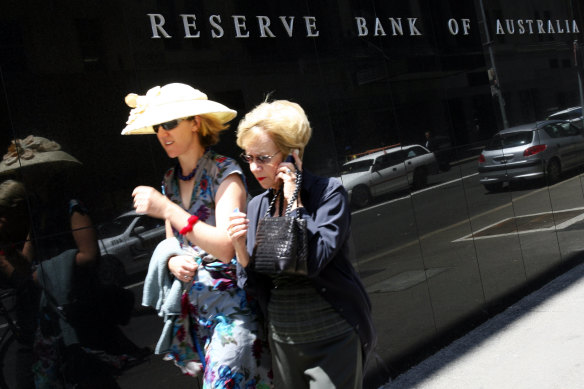RBA leaves borrowers waiting for interest rate relief
By Shane Wright and Millie Muroi
Borrowers will have to wait until next year for interest rate relief after Reserve Bank governor Michele Bullock declared inflation was not falling fast enough despite the bank predicting a rise in unemployment and a slowdown in wage growth.
The Reserve Bank on Tuesday held interest rates steady at 4.35 per cent, as expected by markets and economists, and revealed it believed headline inflation – which fell to a three-year low of 2.8 per cent last week – would edge down to 2.5 per cent by the middle of next year.

The bank has maintained it wants to see inflation “sustainably” in its target band before cutting rates.Credit: Louie Douvis
Bullock, speaking at a press conference following the decision, said while headline inflation had fallen substantially, underlying price pressures were slowing only moderately, with “still a significant amount of inflation in the system”.
She said while underlying inflation did not have to be in the bank’s 2-3 per cent target band for interest rates to be cut, it had to be “sustainably” heading down.
“I don’t think that necessarily means it has to be absolutely back in the band, but we need to be pretty convinced that it’s heading there with a fair level of confidence,” she said.
Economists are expecting an interest rate cut at the bank’s February meeting, but financial markets believe it could be as late as May, which is the latest possible month Prime Minister Anthony Albanese is expected to go to an election.
The bank believes the federal government’s energy subsidies, falling petrol prices and a slowdown in rents will help slow inflation over the coming nine months. Its forecasts, if accurate, would mean inflation within the RBA’s 2-3 per cent target band for a full year for the first time since 2013.
But after reaching 2.5 per cent in the June quarter next year, the RBA believes headline inflation will spike to 3.7 per cent by the end of 2025 as energy rebates end.
Unemployment is tipped to edge up to 4.5 per cent by late 2025, from 4.1 per cent now, while household consumption – which went backwards in the June quarter – is expected to remain soft. Much of the stage 3 tax cuts, which some economists feared would push up inflation, are forecast to be saved while consumers are changing their shopping habits to seek out bargains.
Bullock said despite unemployment being likely to grow, the labour market remained tight.
“It’s not that people will be tossed out of work like in a recession, which is where we see a sharp rise in the unemployment rate,” she said. “It just means that for people coming into the labour force, perhaps it takes them a little longer to get a job than in the past.”
Government spending, including support through aged care and the National Disability Insurance Scheme, continues to add to economic growth, but critics have argued fiscal spending has delayed progress towards lowering inflation. The bank believes public spending is likely to remain “robust” over coming years.
While it is tipped to drop off in the near term, the bank said this was likely to be temporary “given investment spending announced in government budgets and the large pipeline of engineering work yet to be done”.
Business investment is tipped to flatline by year’s end before starting to improve modestly.
The bank noted that population growth was likely to ease a little quicker than it had expected, partly due to the federal government’s changes to foreign student visas. It argued that the absence of migrants would affect the ability of the economy to supply the goods and services demanded by residents.
“This slowing in population growth is expected to weigh on GDP growth from mid-2025,” it said.
“However, it will also reduce the economy’s supply capacity, such that there will not be a material effect on the degree of spare capacity in the economy and therefore inflation.”
AMP chief economist Shane Oliver said an interest rate cut by Christmas was still a chance if unemployment spiked and the next monthly inflation figures showed a further sharp fall in underlying price pressures.
But he said a rate cut in February remained most likely, arguing it was unlikely the RBA would have to wait until May to be confident enough about inflation before easing monetary policy.
Deloitte Access Economics partner Pradeep Philip warned interest rates had already taken effect and needed to be wound back.
“Like a cautious punter stubbornly backing the favourite as the odds shift under it, today’s monetary policy decision shows the Reserve Bank is unwilling to walk away from high interest rates, even as the case for a rate cut continues to make up ground,” he said.
Cut through the noise of federal politics with news, views and expert analysis. Subscribers can sign up to our weekly Inside Politics newsletter.